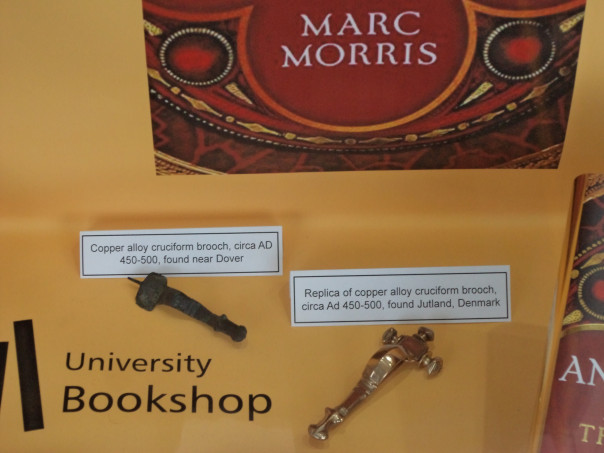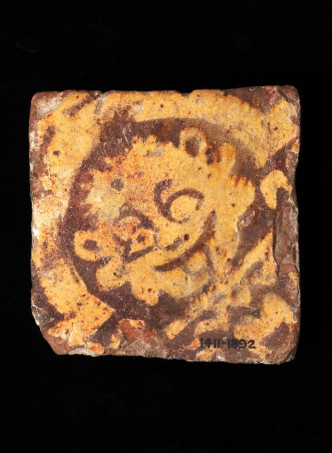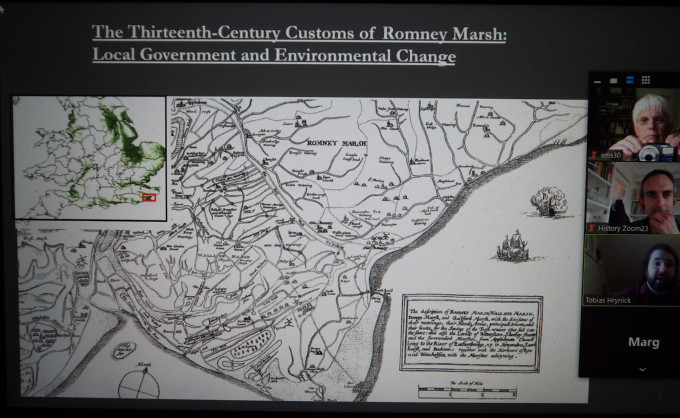Many apologies to all those who wanted to join the ‘In conversation with Dr Marc Morris’ event on Tuesday evening, we experienced major technical issues just as we were getting started. However, Marc is happy to reschedule, and it will now take place on Wednesday 2 June at 7pm using Teams Live Events. We are keeping our fingers very tightly crossed this time!
For those who would like to join this free, open event, here is the new joining url:
or use the short form: https://bit.ly/3fPmMHE Booking is not required and for those who do not have Teams, please follow these instructions: as soon as you click on the link or open it in your browser – if you do not have Teams installed, firstly click ‘cancel’ when it prompts you to open Microsoft Teams; second, select ‘Watch on the web instead’, finally select ‘watch anonymously’ unless you have a Teams or Microsoft account. You will see the event has started or be told, it has not started yet. If the latter, wait for the event to start. There is no limit to the number of times you can retry to enter.

As before this rescheduled public event sees me ‘in conversation’ with Dr Marc Morris about his new book The Anglo-Saxons. A History of the Beginnings of England. Described as ‘A rich trove of ancient wonders’ and ‘An absolute masterpiece’ Marc will take us on a voyage of discovery as he draws on original evidence to explore this only dimly understood period of history. Moreover, during this interview he will help us separate truth from legend as he examines not only the well-known figures but also some lesser-known characters. Please do come and join us and if you would like to buy a copy of Marc’s book, please contact the CCCU Bookshop at: https://bookshop.canterbury.ac.uk/
Also next week, but the evening before ie Tuesday 1 June, Dr Diane Heath is going to give one of the free Open Lectures in the Faculty of Arts, Humanities and Education, beginning at 6.30pm, her talk is entitled ‘Medieval Animals: teaching green heritage to support SEND children’s emotional engagement’. In her lecture she will focus on Medieval Animals and their rich heritage ‘afterlife’ in animal history and culture (think Fantastic Beasts and Pokemon but weirder!). Real and imaginary animals depicted in Kent’s medieval books, paintings and sculpture expressed their times’ sense of wonder in the natural world. Among the examples Diane will consider are the animals found in the Rochester Bestiary, on Faversham’s Painted Column and on Minster in Thanet’s 15th century misericords. For, as Diane will relate, St Anselm and other medieval scholars specifically sought to engage people’s feelings by making animals the bearers of emotional meanings. Bringing this to the present day, as Diane will demonstrate, it is feasible and indeed exciting to reimagine their creativity in vital and fascinating ways to aid SEND children understand their emotions by teaching through local green heritage. Booking is required and please use this link to the booking form: https://www.canterbury.ac.uk/arts-humanities-and-education/events/2021/public-lecture-series-2021.aspx

I thought I would also like to bring you good news about the Lawrence Lyle Memorial Prize which has been awarded to the best Taught MA dissertation in MEMS and Modern History. In 2020 we have three winners, Beth Brown, Lizzie Burton and Ed Skeates. Some of you may remember Beth from her work on the pop-up banners for the exhibition at St Mildred’s church: https://blogs.canterbury.ac.uk/kenthistory/celebrating-st-mildred-and-other-canterbury-and-kent-saints/ For her dissertation she took a somewhat allied topic in that she explored the eschatological, apocalyptic and millenarian mentalities and their associated emotions found in England between 1300 and 1666. This crossing of periods was an important part of her research that deployed several case studies to assess and evaluate such apocalyptic mentalities because often these ideas and the emotions generated are overlooked by historians.
Lizzie, too, worked on the history of emotions, although in her case she focused on the nature of charitable giving and receiving involving the rich and poor during the 17th century. For her evidence, she drew heavily on visual and material culture to explore how charitable activities were depicted across different art forms in this period, while her main source for the poor were the petitions made in the late 16th century. Having explored her key questions such as how the rich and poor conceived of charity and what dominant or hidden emotions she could find through her study, she believes she detected what she sees as a turmoil of emotions for both rich and poor, not least because they were caught in a framework that differentiated between the deserving and undeserving poor, another fascinating study.
Ed looked at how castles were used to imprison people as shown in various chronicles from across the Anglo-Norman world between the 10th and 15th centuries. He looked at different sorts of confinement, how chroniclers presented imprisonment and finally how chronicle translators affect our engagement with these same chronicles. He concluded that within medieval narratives, imprisonment was a valuable tool for the chroniclers regarding ideas such as justice, morality, dynasty and divine providence, more great ideas!
This week among those giving seminar presentations on their current research projects to the School of Humanities and Educational Studies Research Seminar was Dr John Bulaitis. John has been working for several years now on his study of tithe and ‘the tithe wars’ of the early 1930s, especially in Kent and East Anglia, and this summer he hopes to complete his book. As regular readers of the blog will remember, John first spoke about ‘the battle of the ducks’ at the Michael Nightingale Memorial Lecture in 2015. These lectures are a joint venture between the Centre and the Agricultural Museum, Brook, and for those who would like to refresh their memories, here is the blog on this Nightingale Lecture: https://blogs.canterbury.ac.uk/kenthistory/rescuing-ducks-and-liberating-sows-the-kentish-tithe-war/

In some ways as a consequence of John’s interest in the history of tithe, the Centre held a conference on the topic in 2017 entitled ‘Tithe through the Ages: the Historian’s View’ that featured in the blog: https://blogs.canterbury.ac.uk/kenthistory/celebrating-canterbury-conferences-and-paul-bennett-mbe/ Again livestock was to the fore, but perhaps pride of place should go to the tithe pig that was immortalized in porcelain and saw rectors and other clerics becoming the staple fodder of illustrators and cartoonists in the 18th century, who saw the corpulent parson in comparison to his skinny parishioners as an easy target. Moreover, it is also worth noting that resistance to tithe payment has a long history in Kent, albeit there were certain areas in the county where this was far more common, including the Romney Marshes, both in the medieval and Tudor periods.
Keeping with the topic of local versus national and farmers (tenants and owner-occupiers) versus great institutions – Crown, religious houses, I thought I would mention that I tuned into the Cambridge Medieval Economic and Social History seminar this week to see Toby Hrynick’s presentation on ‘Thirteenth-century customs of Romney Marsh: local government and environmental change’. Toby is a student working under the supervision of Professor Maryanne Kowaleski at Fordham University, New York, and I are grateful to her for alerting me to the seminar. Toby concentrated on the mid thirteenth century because this was a period of crisis as great storms battered the coastline of Kent and the low-lying marshland was especially vulnerable to inundation, but it was also a time of political instability, witness the activities of Simon de Montfort.

Toby took his audience through the chronology of the apparent growing use of documents produced by the jurors of Romney Marsh who, while stressing the antiquity and authority of their ancient practices of organizing maintenance of drainage features, were actually ensuring their establishment, perhaps for the first time. Moreover, the jurors recognized the value of having Henry III’s approval because royal legitimacy was important, even from a weakened monarchy, and in fact this weakness may have strengthened the hand of the marshland jurors as they sought to establish their authority over the marshland farmers to contribute towards maintaining drainage and sea defences. Interestingly such developments in Romney Marsh apparently coincide with similar activities in the Rhineland, and the borrowing of words and infrastructure ideas also suggests the presence of specialists in both regions.
This very careful and detailed research is revealing how the local government of marshland drainage developed, as well as the fault lines between the different constituencies on Romney Marsh: the tenants, those from the upper groups in the peasantry, the great landholders, Crown officers such as the sheriff and the king. Consequently, Toby’s presentation generated numerous questions and comments from the audience, and there was general agreement that such a regional study is extremely valuable for the light in sheds on these practices, not least because this in some ways communal governance of the marshland’s defences was seen as a suitable model to be adopted elsewhere, even into the early modern period.

Finally, I thought I would mention that John Hills and I will be doing some filming at St Martin’s lych gate this week as part of an initiative from the sustainability team, including Professor Peter Vujakovic, which is keen to hi-lite biodiversity and heritage on campus and in the UNESCO World Heritage Site. The team would like to engage with a national week celebrating CCCU’s local burial grounds (St Gregory’s and St Martin’s churchyards), hence I’m going to be considering this portal between life and death, a route of passage that none can avoid.
 Centre for Kent History and Heritage
Centre for Kent History and Heritage Sheila Sweetinburgh
Sheila Sweetinburgh 1108
1108

